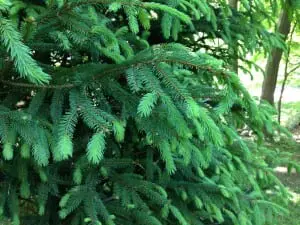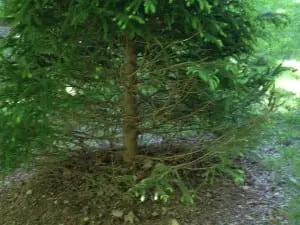By Pamela Doan
Reader question: I planted several Colorado spruce and Norway spruce a few years ago. While the trees seem to be doing fine and are covered in new growth right now, two of the Norway spruce have bare spots where the branches lost their needles. What’s happening?
Roots and Shoots: While spruces are pretty hardy trees there are a few things that can cause problems. Diagnosing the issue will take a little more observation and information.
Spruce does best with full sun, acidic soil and adequate water. They’re adapted to colder climates like ours, and in hot, dry conditions, spruce will suffer. Both of your varieties, Colorado and Norway, are susceptible to drought and even mature trees will need watering, just an inch per week, when there isn’t sufficient rainfall.

If any of these needs aren’t met, the tree might still grow, but it will be weakened and more susceptible to pests and disease. Mistakes made when planting can also affect it. Planting it too deeply or shallowly, burying it in more than 2 to 3 inches of mulch or mulching up to the trunk will prevent the tree from thriving and these mistakes are hard to correct later.
First, try to rule out any issues caused by not meeting these conditions for optimal health. A soil test will determine the quality of nutrients the tree is getting and observation will tell you a lot about everything else.
Pest damage could be detected by checking for the signs of the spider mite, a common spruce invader. Evidence of spider mites could be as obvious as a white web with eggs on a branch or more subtly as discolored needles if the mites have been feeding on it. They’ll go dormant in hot weather, though. The best time to find them is in cooler weather. If you find that the mites are widespread throughout the tree, it might need a pesticide and calling an arborist for assistance will get the best results.
There are several possibilities for damage caused by funguses and pathogens. The range of diseases that infect spruce surprised me. The Illinois Cooperative Extension office has a helpful online resource that identifies the most common. The possibilities that could cause damage like what you’ve described include root rot and spruce needle rust.
Root rot symptoms could be exhibited through dead branches, brown needles and make it look like it’s dying. Although you described your tree as having a lot of new growth, the damage could be in an early stage.
Spruce needle rust has been found throughout our area since the 1990s and infects many trees. It doesn’t usually kill them, but makes them look bad by causing the kind of bare spots that you describe and it gets worse over time. A close look at the needles will help identify it.

The needles will have yellow bands in spring and then show broken pustules. That’s the sign that the fungus is releasing more spores to infect the tree. The issue usually develops lower on the tree, too, so it could explain bare spots on lower branches. It will eventually work its way up the tree. You can find images of infected needles online to help identify it.
Pruning infected areas of the tree early on may help contain it. A fungicide can be applied by an arborist if the problem needs more attention. In either case, if the tree is valuable to your landscape, and most are, contacting a professional for help is always a good choice. An arborist is one possibility and the Putnam County Cooperative Extension Office offers diagnostic services, too, that are either free or low cost and they can also help you figure out a plan to save the tree. (More about rust here.)
As our climate warms and we’re faced with summer droughts and heat waves more frequently, doing everything we can to help preserve these native trees is worth the effort. Our forests are struggling with climate change, new pests and pathogens and challenges from invasive plants. Closely observing changes in our landscape can catch the kinds of problems you’re noticing quickly before it becomes too advanced.
Submit your garden questions to [email protected] or leave them on our Facebook page.
Photos by P. Doan

